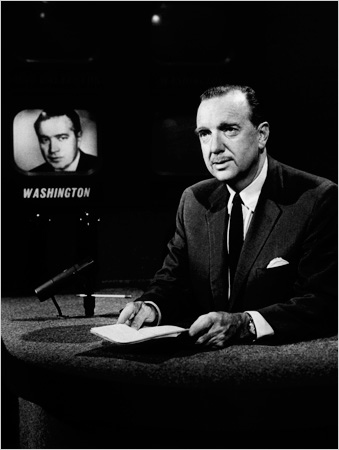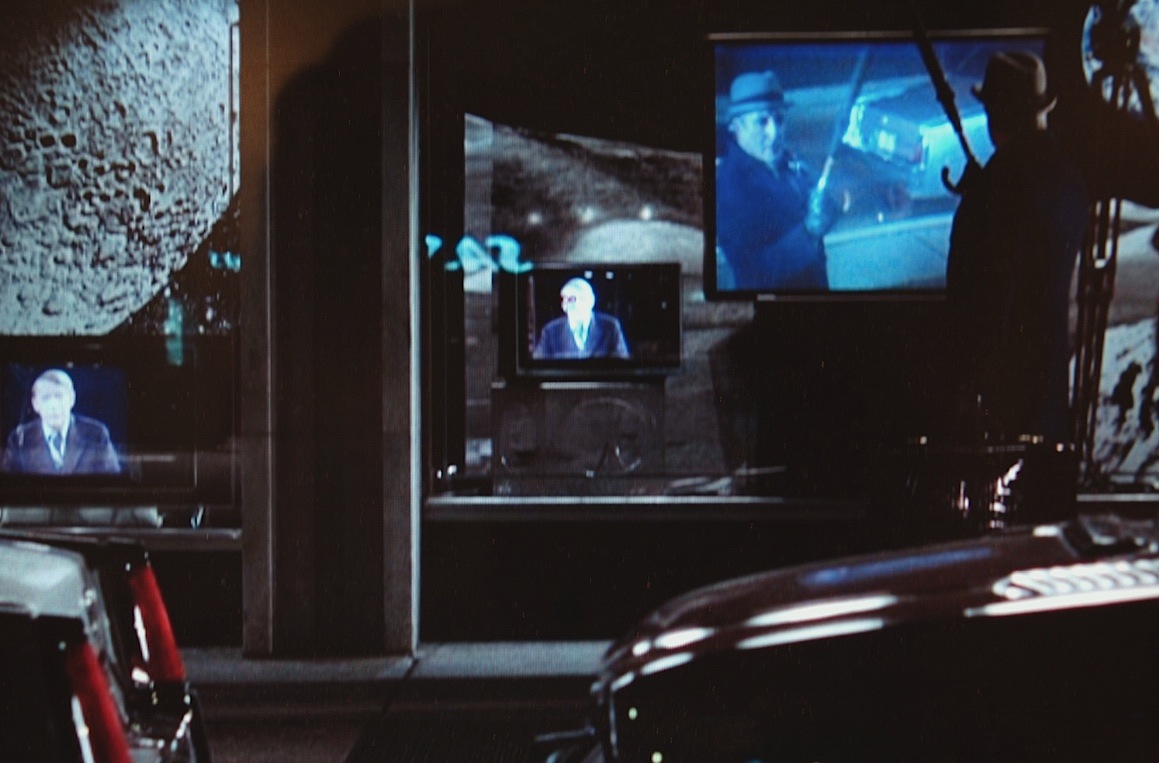By guest correspondent Elisabeth Ross.
Earlier this week, the New York Times reported the death of Walter Cronkite with the headline, “Trusted Voice of TV News.” That sentiment was echoed in obituaries across the country, many of which also suggested that there had been a decline in the character and credibility of news coverage from the days of network television. The Times story also included this front-page photograph:

This image of Cronkite seated in front of television monitors hardly seems noteworthy, beyond serving as a fitting visual tribute to the news anchor whose career spanned the history of television news itself. Of course, much has changed on both sides of the camera. Cronkite’s pose here captures a sense of the newsroom as command center, a somber stage free of the competing visual cues of contemporary media sprawl.
Consider the subtle background: barely visible behind Cronkite, stacked next to the active screen in the image, are three additional monitors, each blank, waiting for a control-room command. In the hierarchy of the nascent television newsroom of the 1950s, man still dominated machine, and the trustworthiness and reliability of the medium rested largely in the projection of the self-assured anchor. The era’s bulky media equipment ensured that control over media images lay in the hands of a few professionals. In the days before the now essential teleprompter, the news is literally in Cronkite’s hands.
Most obituaries could not help quoting Cronkite’s signature sign-off, “And that’s the way it is,” a trademark phrase that, together with news show titles such as “You are There” and “See it Now,” played on the early television audience’s need to be reassured that they were experiencing something real. Television anxiety is, after all, as old as television itself. The medium that came of age during McCarthyism and the Cold War was prone to a paternalistic model of the authoritative screen, one whose audience–with far fewer screens to choose from–was alternately transfixed by and mistrusting of the powerful images newly anchored in their living rooms.
Not that there haven’t been dissenting voices. Director Hal Ashby’s 1979 film Being There mocks the very idea that TV can bring the audience “there,” “now” or anywhere resembling reality. When the simple-minded main character Chance Gardener, played by Peter Sellers, leaves his television-riddled home for the first time, he is armed only with his remote control. The little hand-held piece of equipment appears laughable (and is promptly put to humorous effect by Sellers). It soon becomes clear, however, that Chance and everyone else is already enmeshed within an enormous technological apparatus–one in which the news can never be “the way it is.”

In the thirty years since the release of Being There, equipment such as bulky cameras and big screens has been augmented by powerful small technologies such as the portable, wireless digital recording device. The possibilities for visual media experiences that could be called “You are There” and “See it Now” have grown, as has the media savvy of the viewing public, which itself is armed with increased means of capturing and deploying images through an ever-expanding variety of media outlets.
Cronkite’s death was lamented by most commentators as the end of an era in television news. Certainly there has been a changing of the guard, not least because the public is no longer limited to the chronic mindlessness of network news. When that change opens possibilities for increased reflexivity and citizen participation, “the way it is” can take on richer meaning, expressed by competing voices and disruptive images, meaning that hopefully reflects the complexity of relationships that in turn drives the critical consciousness of the viewing public.
Photograph of Cronkite from Bettmann/Corbis. Screen grab from Being There (Director Hal Ashby, Warner Brothers, 1979) taken on 7/23/09. Elisabeth Ross is a graduate student in the program in Rhetoric and Public Culture, Department of Communication Studies, Northwestern University. You can contact Elisabeth at e-ross@northwestern.edu.
And there’s one more layer to that photo: the man in the screen image, above “Washington”, seems to be watching Cronkite with a wary eye as the latter reports the news. The unintentional implication is that the Washington establishment of the day worried about what Cronkite (speaking to truth) would report on them. Contrast this to today, when Washington can comfortably rely on the media to meekly submit to DC’s power and believe almost whatever they’re told.